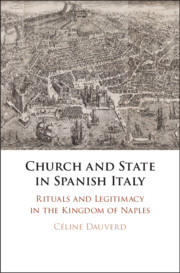Book contents
- Church and State in Spanish Italy
- Church and State in Spanish Italy
- Copyright page
- Contents
- Figures
- Table
- Acknowledgments
- Introduction
- 1 The Spaniards in Charitable Institutions
- 2 Viceroys, Jews, and Conversos
- 3 The Miracle of San Gennaro
- 4 Easter Processions
- 5 Corpus Domini Celebration
- 6 San Giovanni a Mare
- Conclusion
- Bibliography
- Index
1 - The Spaniards in Charitable Institutions
Published online by Cambridge University Press: 09 March 2020
- Church and State in Spanish Italy
- Church and State in Spanish Italy
- Copyright page
- Contents
- Figures
- Table
- Acknowledgments
- Introduction
- 1 The Spaniards in Charitable Institutions
- 2 Viceroys, Jews, and Conversos
- 3 The Miracle of San Gennaro
- 4 Easter Processions
- 5 Corpus Domini Celebration
- 6 San Giovanni a Mare
- Conclusion
- Bibliography
- Index
Summary
Greek mythology recounts that the siren Parthenope, devastated at her inability to make Ulysses fall in love with her on his way back from Troy, swam ashore in the Bay of Naples and died of a broken heart. In an attempt to live down this sad legend, Naples has always been known as a safe and friendly haven for those who may have fallen victim to misfortune and might be in need of nurture and sustenance. The figure of Parthenope has thus become a symbol of the city’s lore and iconography for offering refuge to the needy. It is in this context of safeguard, protection, and relief that this chapter develops. Since the times of the ancient Mediterranean, those who ruled Naples strove to integrate the Parthenopean concept in maxims of government because it was meaningful to its inhabitants. This chapter explores the viceroys’ spiritual care, social pledge, and moral commitment to the region.
- Type
- Chapter
- Information
- Church and State in Spanish ItalyRituals and Legitimacy in the Kingdom of Naples, pp. 31 - 63Publisher: Cambridge University PressPrint publication year: 2020

